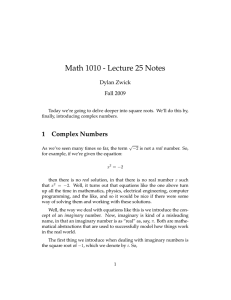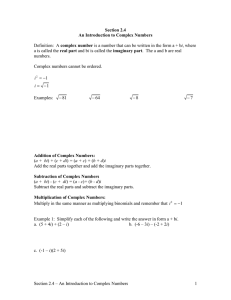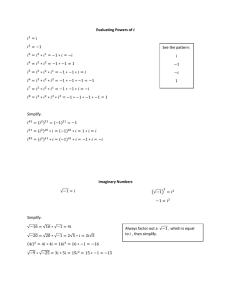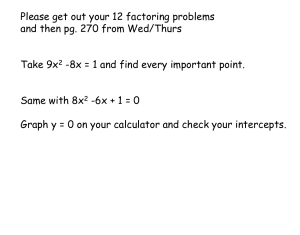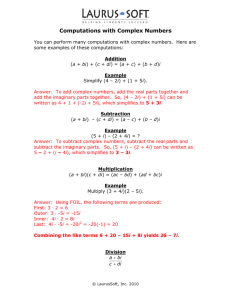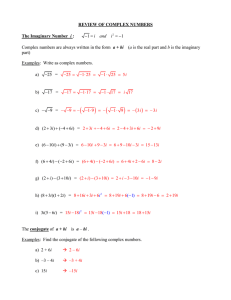Math 1010 - Lecture 25 Notes Dylan Zwick Fall 2009
advertisement
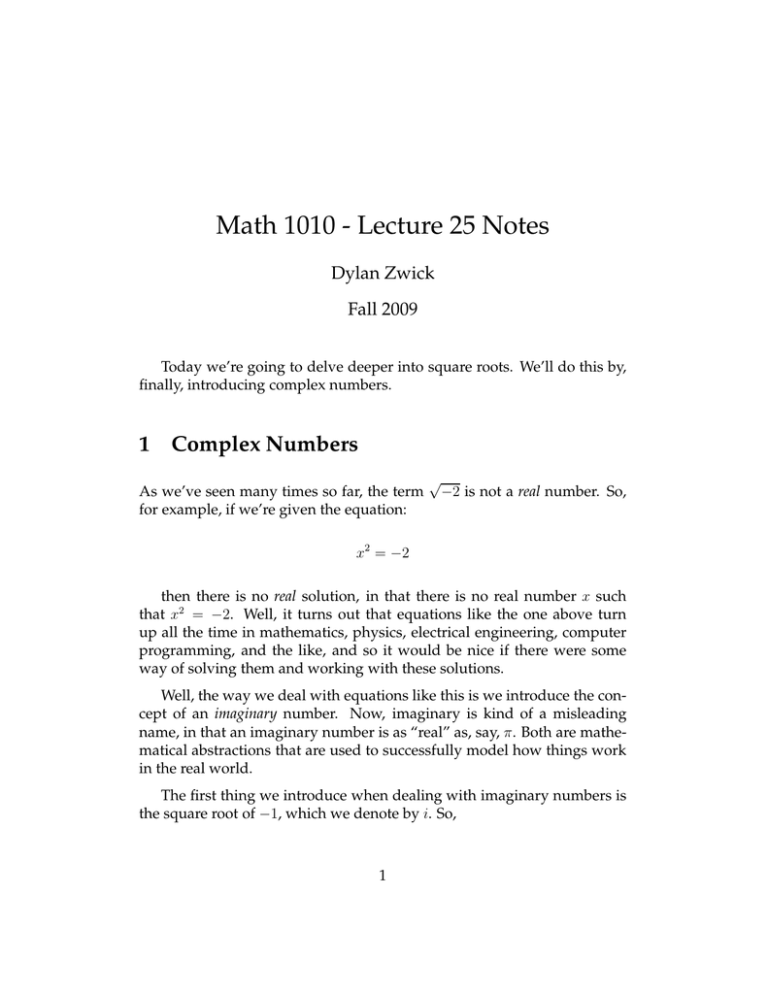
Math 1010 - Lecture 25 Notes Dylan Zwick Fall 2009 Today we’re going to delve deeper into square roots. We’ll do this by, finally, introducing complex numbers. 1 Complex Numbers As we’ve seen many times so far, the term for example, if we’re given the equation: √ −2 is not a real number. So, x2 = −2 then there is no real solution, in that there is no real number x such that x2 = −2. Well, it turns out that equations like the one above turn up all the time in mathematics, physics, electrical engineering, computer programming, and the like, and so it would be nice if there were some way of solving them and working with these solutions. Well, the way we deal with equations like this is we introduce the concept of an imaginary number. Now, imaginary is kind of a misleading name, in that an imaginary number is as “real” as, say, π. Both are mathematical abstractions that are used to successfully model how things work in the real world. The first thing we introduce when dealing with imaginary numbers is the square root of −1, which we denote by i. So, 1 i= √ −1. It turns out that this is the only new number we need. We can express the square root of any negative number as a real number multiplied by i. So, for example: √ −16 = p (16)(−1) = √ √ √ 16 −1 = 4 −1 = 4i, and that’s how we’d write it, 4i. Examples. 1. √ √ 2. −49. −49 = r − r √ √ 49 −1 = 7i 20 . 49 20 − = 49 r √ √ 20 √ 20 2 5 i −1 = √ i = 49 7 49 Now, to perform operations with square roots of negative numbers, you must first write the numbers in i-form. You can then add, subtract, and multiply as follows: ai + bi = (a + b)i ai − bi = (a − b)i (ai)(bi) = (ab)(−1) = −ab 2 Examples 1. √ √ 2. √ √ 3. −25 + −25 + −25 − −25 − √ √ −64. −64 = 5i + 8i = 13i. √ √ −9. −9 = 5i − 3i = 2i. √ −7 −7. √ √ √ √ √ −7 −7 = ( 7i)( 7i) = ( 7)2 i2 = 7(−1) = -7. √ Now, on this last example it’s very important to write it in i form first. If we didn’t do this, and instead did the following calculation: √ p √ √ −7 −7 = (−7)(−7) = 49 = 7 (NOTE: THIS IS THE WRONG WAY TO DO IT! then we’d get the wrong answer. You have to convert to i-form first. Now, we can combine real and imaginary numbers to get complex numbers. A complex numbers is a number in the form: a + bi where a and b are real numbers.1 This way of writing a complex number is called standard form. If a = 0 then we say it’s a pure imaginary number. These are the numbers we’ve been dealing with so far in this lecture. If b = 0 then this is a real number, and these are the numbers we’ve been dealing with this entire class before this lecture! We say two complex numbers are equal if both their real parts and their complex parts are equal. So, 1 In mathematical terminology, we’d write this as a, b ∈ R. 3 2 + 3i = 3i + 2, but 2 + 3i 6= 2 + 4i, even though the real parts of the second pair of numbers are equal. Note that the number on the left of the first equation is not in standard form. Now, we can add, subtract, and multiply complex numbers. To add or subtract complex numbers, you just add or subtract the real and complex parts: (a + bi) + (c + di) = (a + c) + (b + d)i (a + bi) − (c + di) = (a − c) + (b − d)i The commutative, associative, and distributive properties of real numbers are also valid for complex numbers, as is the FOIL method. Now, for any complex number we define its complex conjugate by switching the sign in front of the imaginary term. So, the conjugate of a + bi is a − bi. If we multiply a complex number by its conjugate, we get a real number. For example: (2 + 3i)(2 − 3i) = 4 + 6i − 6i + 9 = 13 and in general (a + bi)(a − bi) = a2 + b2 . If we have the quotient of two complex numbers, we can get it in standard form by multiplying the top and bottom by the conjugate of the denominator. Examples Calculate the following, and give all answers in standard form. 4 1. (4 + 6i) + (15 + 24i). (4 + 6i) + (15 + 24i) = 19 + 30i. 2. 22 + (−5 + 8i) + 10i. 22 + (−5 + 8i) + 10i = (22 − 5) + (8i + 10i) = 17 + 18i. 3. (4 + 3i)(−7 + 4i) (4 + 3i)(−7 + 4i) = −28 − 21i + 16i − 12 = -40 -5i. 4. 5 + 3i 7 − 4i 5 + 3i = 7 − 4i 5 + 3i 7 − 4i 7 + 4i 7 + 4i = 35 − 20i + 21i + 12 47 + i = . 49 + 16 65 5
